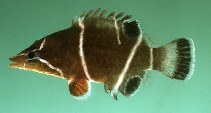| Family: |
Labridae (Wrasses), subfamily: Cheilininae |
| Max. size: |
6 cm TL (male/unsexed) |
| Environment: |
reef-associated; marine; depth range 8 - 42 m |
| Distribution: |
Indo-Pacific: East Africa to the Hawaiian and Society islands, south to the Great Barrier Reef; Pohnpei and Marshall Islands in Micronesia. |
| Diagnosis: |
Dorsal spines (total): 9-9; Dorsal soft rays (total): 10-11; Anal spines: 3-3; Anal soft rays: 8-8; Vertebrae: 23-23. Closely resembles juveniles of Cheilinus fasciatus and Epibulus insidiator. Since they have broadly overlapping meristics, color pattern is the only reliable distinguishing character (Ref. 1602). Body of adults when fresh grayish brown, becoming reddish brown on mid side and ventrally on some specimens. Head with narrow, diagonal pale bands radiating from the orbit; iris bluish with reddish inner rim and an upper and lower streak of pale yellow. A large black spot covering more than half of pelvic fin. One predorsal bone. Premaxilla protractile. Spinous portions of dorsal and anal fins deeply incised. |
| Biology: |
Inhabit caves or crevices of lagoon and seaward reefs and drop-offs (Ref. 37816). Benthic and benthopelagic (Ref. 58302). Specimens usually taken at depths of at least 30 m. Secretive (Ref. 37816). |
| IUCN Red List Status: |
Least Concern (LC); Date assessed: 02 March 2009 Ref. (130435)
|
| Threat to humans: |
harmless |
Source and more info: www.fishbase.org. For personal, classroom, and other internal use only. Not for publication.

